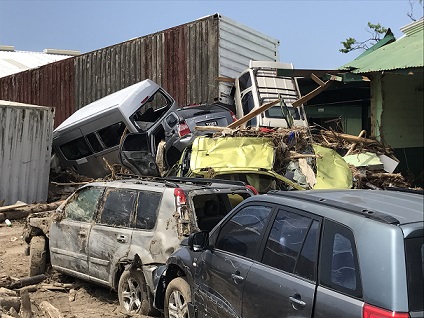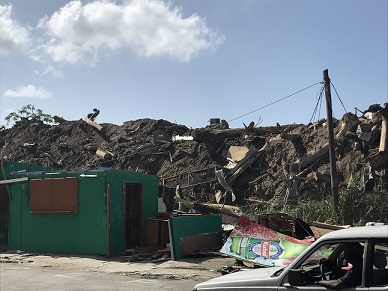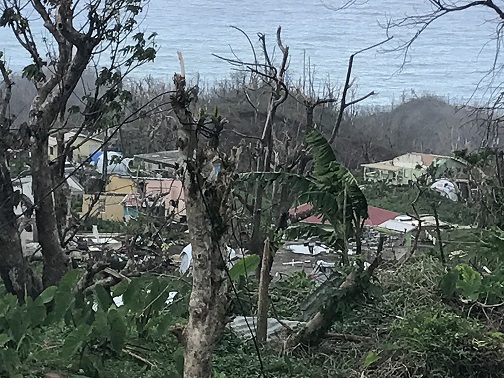|
|
TDN Radio and Hurricane Maria coverage: The Voice in the Dark
By By Nicole Georges
November 10, 2017 12:45 P.M

Maria heaped unprecedented carnage on the Island. |
Roseau, Dominica (TDN)
- Sunday, 17th September, 10:00am: Dr. Thomson Fontaine is on his “Lifeline” Program on Q95 FM discussing the imminent passage of Hurricane Maria through the Windward Islands. He cautions that due to the low wind shear, extremely warm ocean, and excessive moisture, Hurricane Maria will drastically increase in strength. He predicts that the eye will pass directly over Dominica sometime during Monday night.
Monday, September 18th, 3:00 p.m: Q95FM radio shuts down its physical headquarters in Dominica as staff head for home to take cover. At that time, TDN Radio remotely takes over local broadcasting to Dominicans on island, and the internet component of Q95 FM. Local media in Dominica continues to broadcast. Dr. Fontaine takes over the role of announcer from Lennox Linton so that Q95 FM can continue to inform local residents of the approach of the storm, and its time of passage over the island.
6:00 p.m. He accurately indicates the eye of the storm will pass over Dominica at around 9:00pm, and will linger over the island until at least 3:00-4:00 a.m. He forecasts the approximate path of the storm over the island as entering over Petite Savanne, working its way across the middle of the island, and exiting towards the north.
He warns that at 165mph, Hurricane Maria is a dangerous category 4 storm; a fearsome combination of Tropical Storm Erika and Hurricane David, because of the amount of rain and wind expected. He urges residents who experienced the mudslides and flooding of Tropical Storm Erika to evacuate and leave any homes that appear unable to withstand the storm force winds.
7:00 p.m: Storm winds and rains begin to buffet the south of the island; electrical power begins to go out. TDN begins to receive calls from frightened relatives in contact with family in Dominica who relay harrowing reports of galvanized roofs being wrenched away before their eyes.
Tensions begin to heighten and the sense of unease swiftly turns into horror as Hurricane Maria strengthens into a category 5. Dr. Fontaine speaks to Joshua Francis on air. The freight train-like roar of the wind can be heard through Francis’s barely audible side of the conversation. Hurricane Maria has begun its savage assault on the island.
The frantic calls for help from Dominicans on island intensify over the next 8 hours to family members overseas who could only listen helplessly in despair. Anxious relatives tune in to Q95 and TDN Radio for any information they can glean.
3:00 a.m: All communication out of the island ceases.
And then…silence.
Aftermath:
Dr. Fontaine estimated the time of Maria’s exit from Dominica at around 3:45 to 4:00 A.M. The storm had moved on, but there was no word as to the extent of the damage suffered. As the silence stretched on hour after hour, the calls from the incredulous Dominican diaspora poured through the on air telephone lines; over 4000 calls, messages and texts assailed Fontaine on the first day after the storm. He doggedly took the calls and gave updates.
At one point, he published the call signs of the Ham Radio operators in Dominica and urged listeners who were able, to attempt to listen in.

A storm for the century. |
Tuesday September 19th, 4:00 p.m. Julian Antoine, a Ham radio operator in the United States, finally honed in on one-way radio traffic from Dominica. On the other end was Ham operator John Christian who had trekked from his home in Kingshill to get into town to set up and try to make contact with the outside world. Around the same time, another U.S based operator Stuart Gittings also made contact. Their first reports were relayed through TDN radio: “island totally devastated urgent need for medical and emergency assistance, almost every building has suffered damage, our people are in shock, reports of many casualties.”
Therefore, the world learnt for the first time the truly horrific nature of Hurricane Maria’s impact on Dominica as it took lives, destroyed homes and wiped out communications.
TDN management began to call in reinforcements to operate the lines, and take on shifts after Dr. Fontaine completed a record twenty-four hours straight on air. The announcers did what they could to keep listeners calm and optimistic while battling their own fears and concerns.
The full scope of the disaster was painfully and slowly revealed through those long hours. Dominica had suffered a devastating blow unlike anything experienced in its history. Not even Hurricane David, the storm that altered the island so drastically in 1979, had caused the level of damage wrecked by Hurricane Maria.
The relay of announcers began as the vigil for Dominica continued through the first few days after the Storm, from Dr. Fontaine in South Sudan to Sam George in Texas to Nicole Georges-Bennett in Toronto to Anthony Drigo in New York and back again to South Sudan.
As volunteer announcers tag teamed to keep listeners informed on the latest developments post Hurricane Maria, communication from Dominica remained sporadic. Prime Minister Roosevelt Skerritt reported a clear and bleak picture of what had happened to the island on Antiguan media.
Ninety-five per cent of the housing stock had been destroyed, flora and fauna were no more; the great trees of the rain forest snapped like toothpicks and barks ripped off so as to appear obscenely skinned; a death toll that was rising and unknown numbers missing.
Unprecedented destruction

Widespread devastation after Maria. |
TDN staff did what they could to keep their radio audience informed with what little facts they could verify, mainly through the ham radio operator network in Dominica. Even this was challenging as radio operators tried to conserve dwindling battery power and kept their reports limited to once or twice a day.
The toll on the on-air staff, also dealing with the stress of not hearing from loved ones, began to be evident, and so other broadcasters from the diaspora offered to do relief shifts. Gisele Francis and Peter Thomas took on shifts to help ease the workload, bringing new energy to the airwaves. The Station management agreed to continue the relay of announcers for as long as it took until proper communication with the island could be re-established.
In the days that followed, the chaos and trauma of what had happened escalated as reports of armed and indiscriminate looting emerged. The ports and airports were not usable and food and water were running out. However, regional support from islands like Martinique, Guadeloupe, Antigua, Barbados, St. Lucia, Jamaica, and Trinidad and Tobago was quickly mobilized, while the diaspora jumped into action to secure relief supplies and get them into Dominica by any means necessary.
TDN Radio provided a sounding board for callers, and aired some of the text and voice messages from people on island once Digicel and Flow resumed limited service. TDN also followed regional media and relayed any relevant news, including the Prime Minister’s U.N address and government’s daily press briefings.
The Road Ahead
In the weeks since the passage of Hurricane Maria, TDN Radio has continued its online collaboration with Q95FM Radio and carried out its mandate to inform, educate and entertain; being a beacon for the voices of Dominicans both on and off island. TDN Radio will now play its part in the reconstruction of Dominica, and contribute to the rebuilding of a stronger, better Dominica.
We are here to serve you.
Aprés Bondie C’est La Tere.

|
|
|
